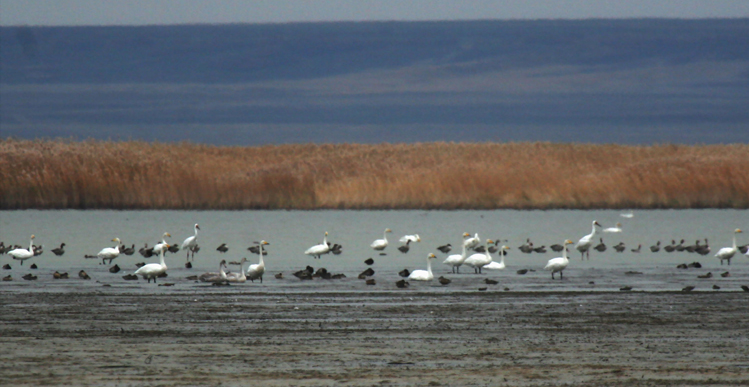Safe Flyways: New Project to Increase Waterbird Monitoring in Central Asia

Siberian Cranes © International Crane Foundation
The Siberian Crane is a majestic migratory bird. In the summer, it lives and breeds in Arctic Russia before flying thousands of kilometers south to spend the winter in Iran, India or China. However, the existence of the Siberian Crane is threatened. With a global population of only 3500-4000 and just 10-20 individuals remaining in Western and Central Asia, the species is classified as “Critically Endangered”. As a result of this conservation status, the Siberian Crane is listed under both Appendices of the Convention on Migratory Species (CMS) and is subject to an international Memorandum of Understanding (MOU) designed to promote cooperation amongst signatories.
To complete its annual cycle, the Siberian Crane relies on the Central Asian Flyway, a vast network of habitats and fly routes covering 34 million square kilometers across 29 different nations in Central and Western Asia. As one of the eight major flyways of the world, the Central Asian Flyway is utilized by 307 species of migratory birds and provides important habitat for summer breeding and winter roosting. The sites that make up the flyway are also important stop-over places for migratory birds, where species can rest and recharge for their remaining journey.
Like the Siberian Crane, a number of other waterbirds in the Central Asian Flyway are threatened. Aware of the need to increase our understanding of waterbirds in the Central Asian Flyway, the CMS Small Grants Programme is supporting the project “Safe Flyways: Monitoring threatened waterbirds along the Central Asian site network”.
The project, to be undertaken by Kazakhstani conservation NGO Naurzum, aims to establish and strengthen monitoring activities on cranes and other important waterbird species in the Central Asian Flyway. In particular, the project will focus on the Siberian Crane and its habitat, contributing valuable data on crane populations, habitat needs and conservation issues to international monitoring and habitat databases. In addition, the project will investigate potential new sites in the flyway and examine the relationships between waterbird distribution, habitat condition and climate change.
The potential new sites will be evaluated with a view to their inclusion in the Western and Central Asian Site Network. This network is a key example of how to enhance connectivity among internationally important sites. It also provides a model for the work on ecological networks currently being pursued under CMS.
The project will also raise conservation awareness amongst important stakeholders, such as hunters, fishermen, shepherds and students. Through collaborative and inclusive activities such as joint-monitoring with hunters, sharing of information and organizing crane celebration activities, the project will actively engage stakeholders and communities close to the monitoring sites.
These activities will help form a greater understanding and appreciation of migratory waterbirds amongst stakeholders, whilst building support for future monitoring and conservation activities. Furthermore, the population and habitat information reported will make valuable contributions to the Siberian Crane MoU and other initiatives aimed at conserving migratory waterbirds in the Central Asian Flyway.
The project will be undertaken from March 2015 to September 2016.
For more information please contact the CMS Avian Species Officer, Dr. Borja Heredia at [email protected]
Related links:
Last updated on 13 March 2015


